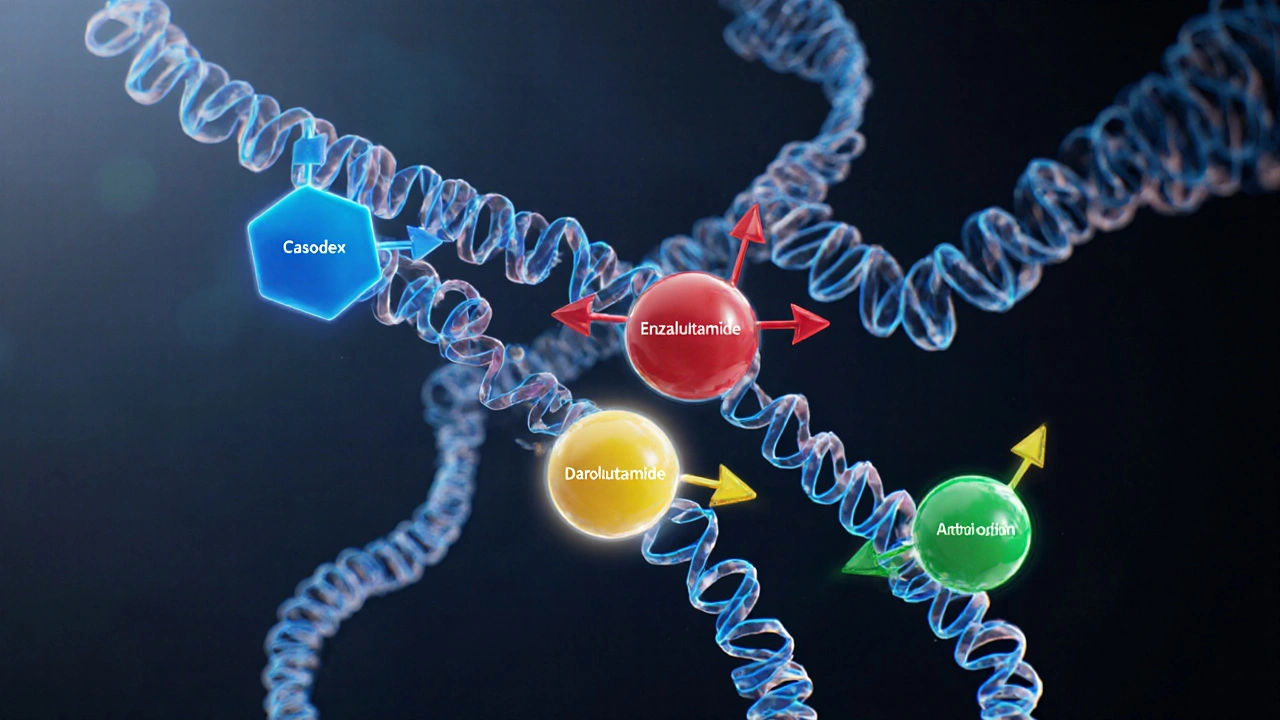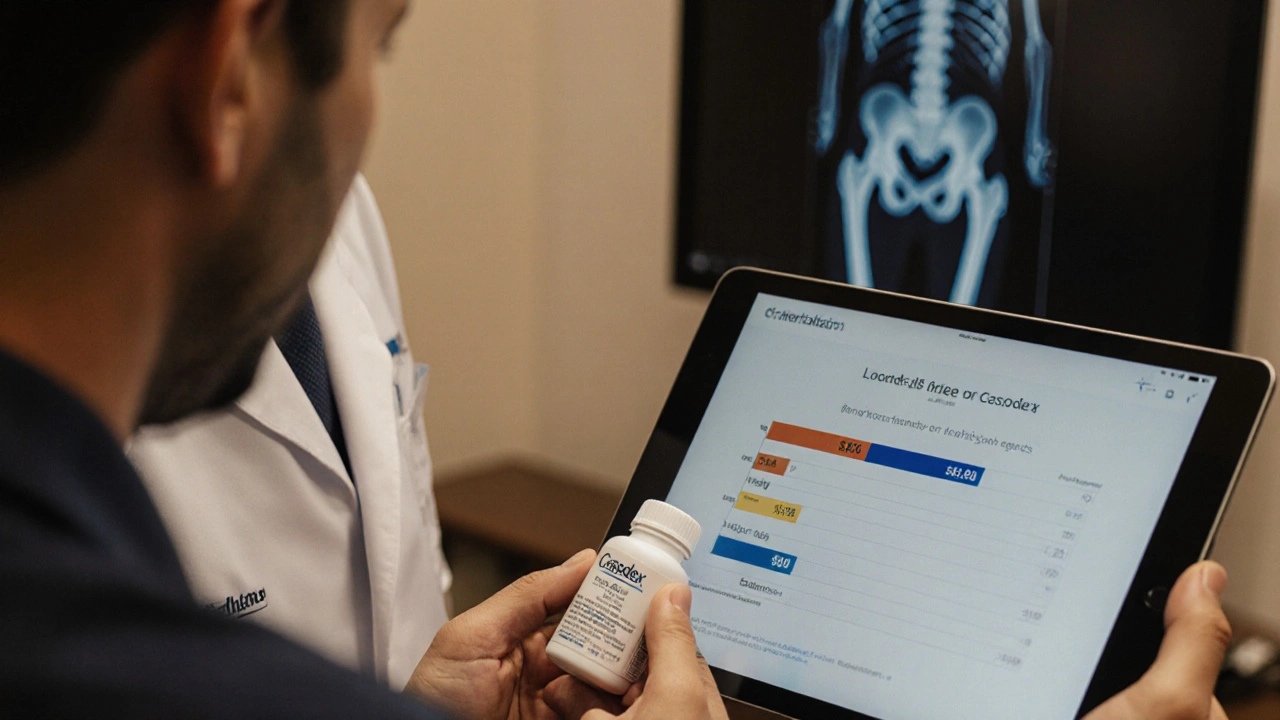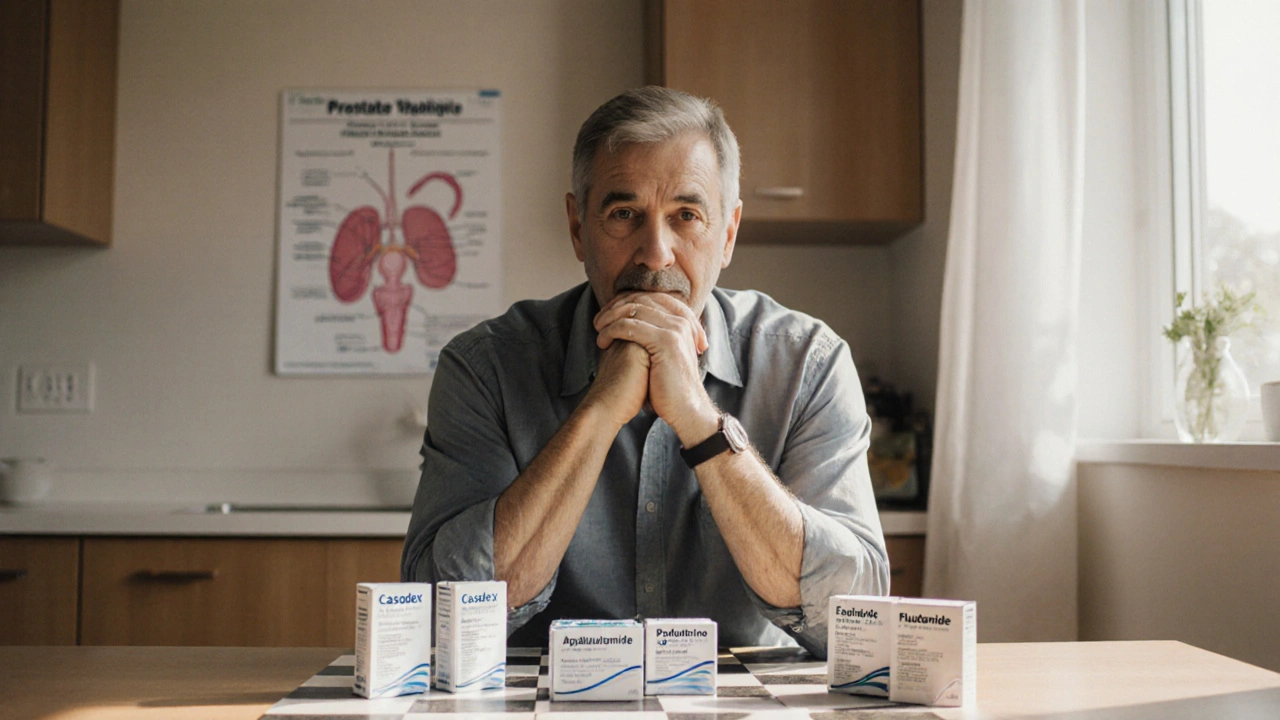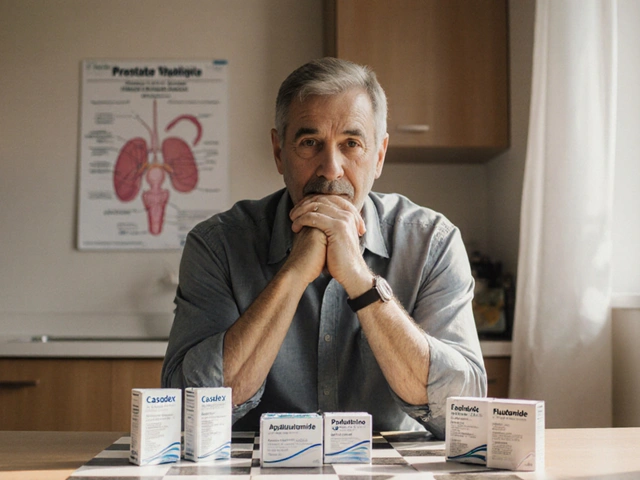Antiandrogen Selection Guide
Select Your Treatment Factors
Your Recommended Antiandrogen
Select your treatment factors above to see your personalized recommendation
When men face prostate cancer, choosing the right antiandrogen can feel like a high‑stakes puzzle. Casodex is the brand name for bicalutamide, a non‑steroidal antiandrogen approved in 1995 to block testosterone‑driven tumor growth. It’s widely prescribed, but a growing list of newer drugs promises stronger tumor control or fewer side effects. This guide breaks down how Casodex measures up against the most common alternatives, helping you weigh efficacy, safety, and cost before you or your doctor decide.
Key Takeaways
- Casodex remains a solid first‑line option for many, especially when combined with hormone‑lowering injections.
- Enzalutamide and Apalutamide offer higher androgen‑receptor affinity but can raise seizure risk.
- Darolutamide shows the lowest central‑nervous‑system side‑effect profile among the newer agents.
- Older drugs like Flutamide and Nilutamide are less expensive but carry more liver‑toxicity concerns.
- GnRH analogues (Leuprolide, Degarelix) work differently-by shutting down testosterone production-so they’re often paired with antiandrogens rather than swapped.
How Antiandrogens Work: The Core Mechanism
All the drugs in this comparison target the androgen‑receptor (AR) pathway, but they do it in slightly different ways:
- Receptor antagonism - The medication binds to the AR without activating it, stopping testosterone and dihydrotestosterone from triggering tumor growth. Casodex, Enzalutamide, Apalutamide, Darolutamide, Flutamide, and Nilutamide belong here.
- Testosterone suppression - GnRH agonists (Leuprolide) or antagonists (Degarelix) lower circulating testosterone, indirectly starving the tumor.
Understanding this split helps you see why doctors sometimes prescribe a combination: an antiandrogen blocks any residual AR activity while a GnRH agent slashes testosterone levels.
Side‑Effect Profiles at a Glance
Side effects often decide which drug a patient can tolerate long‑term. Below are the most common adverse events for each agent:
- Casodex - Hot flashes, breast tenderness, mild liver‑enzyme elevations.
- Enzalutamide - Fatigue, hypertension, occasional seizures, higher risk of falls.
- Apalutamide - Rash, hypertension, diarrhea, low‑grade seizures.
- Darolutamide - Very low CNS penetration, so fewer seizures; still causes fatigue and joint pain.
- Flutamide - Pronounced liver toxicity, nausea, diarrhea.
- Nilutamide - Visual disturbances, liver toxicity, nausea.
- Leuprolide - Hot flashes, bone‑density loss, injection‑site pain.
- Degarelix - Injection‑site reactions, initial testosterone surge, mild flu‑like symptoms.
Patients with pre‑existing liver disease usually avoid Flutamide or Nilutamide. Those with seizure history steer clear of Enzalutamide and Apalutamide.

Direct Comparison Table
| Drug (Brand) | Mechanism | FDA Approval | Typical Daily Dose | Main Side Effects | Approx. Annual Cost (US$) |
|---|---|---|---|---|---|
| Casodex (bicalutamide) | AR antagonist | 1995 | 50mg | Hot flashes, breast tenderness, mild liver ↑ | ~$1,200 |
| Xtandi (enzalutamide) | AR antagonist (high affinity) | 2012 | 160mg | Fatigue, hypertension, seizures (rare) | ~$12,000 |
| Erleada (apalutamide) | AR antagonist | 2018 | 240mg | Rash, hypertension, diarrhea | ~$10,500 |
| Nubeqa (darolutamide) | AR antagonist (low CNS penetration) | 2019 | 600mg | Fatigue, joint pain, minimal seizures | ~$13,000 |
| Flutamide (generic) | AR antagonist | 1990 | 250mg TID | Liver toxicity, nausea | ~$600 |
| Nilutamide (Bicalut®) | AR antagonist | 1995 | 300mg | Visual disturbances, liver toxicity | ~$800 |
| Leuprolide (Lupron) | GnRH agonist - suppresses testosterone | 1985 | 3‑month depot injection | Hot flashes, bone loss | ~$2,300 |
| Degarelix (Firmagon) | GnRH antagonist - rapid testosterone drop | 2008 | Monthly injection | Injection‑site reaction, flu‑like | ~$4,500 |
When to Choose Casodex Over Newer Agents
Casodex shines in three scenarios:
- Cost‑sensitive patients - Its generic price is a fraction of the newer oral agents.
- Combination therapy starters - When paired with a GnRH agonist, Casodex offers solid AR blockade without the added seizure risk.
- Patients with mild liver function - Routine monitoring keeps enzyme rises in check, and most tolerate the drug well.
However, if disease progression occurs despite castration‑level testosterone, the higher‑affinity drugs (Enzalutamide, Apalutamide, Darolutamide) often become second‑line choices.
Choosing a Newer Antiandrogen: What Factors Matter?
Beyond price, think about these decision points:
- Metastatic vs. non‑metastatic disease - Darolutamide received FDA endorsement for non‑metastatic castration‑resistant prostate cancer because of its low CNS side‑effect profile.
- Seizure history - Enzalutamide and Apalutamide have documented seizure cases; Darolutamide is safer here.
- Bone health concerns - GnRH analogues accelerate bone loss, so patients needing bone‑protective agents may prefer an AR antagonist‑only regimen.
- Drug-drug interactions - Enzalutamide is a strong CYP3A4 inducer, affecting many concurrent meds. Casodex has fewer interactions.

Practical Tips for Switching or Starting Therapy
- Never stop a GnRH agent abruptly; a short testosterone surge can worsen symptoms.
- When moving from Casodex to a newer AR antagonist, give a 1‑week washout if liver enzymes are elevated.
- Schedule liver function tests at baseline, then every 4‑6weeks for the first three months on Flutamide or Nilutamide.
- Consider bone‑density scans before starting any GnRH‑based regimen; supplement calcium and vitaminD as needed.
- Discuss insurance coverage early - newer agents may qualify for specialty pharmacy programs that reduce out‑of‑pocket cost.
Future Directions: What’s Coming After the Current Generation?
Research is already looking at next‑generation AR degraders (e.g., PROTACs) that could eliminate the receptor entirely, potentially bypassing resistance mechanisms seen with current antagonists. Until those hit the market, the choice between Casodex and its rivals hinges on balancing efficacy, tolerability, and affordability.
Frequently Asked Questions
Is Casodex still effective for advanced prostate cancer?
Yes. In many patients, especially when combined with a GnRH agonist, Casodex achieves similar biochemical control to newer agents while keeping costs low. Its effectiveness can wane if cancer becomes resistant, at which point a switch to enzalutamide or darolutamide is common.
What are the main reasons doctors prescribe enzalutamide over Casodex?
Enzalutamide binds the androgen receptor with higher affinity and also prevents nuclear translocation, giving stronger tumor suppression. It’s chosen for patients whose disease progresses despite castration‑level testosterone or who need a single oral regimen without GnRH injections.
Are there any diet or lifestyle changes that improve antiandrogen therapy?
Maintaining a balanced diet rich in omega‑3 fatty acids, staying physically active, and limiting alcohol can reduce hot flashes and protect bone health. Some patients also benefit from a low‑glycemic diet that helps manage weight gain linked to hormone therapy.
How do I know if my liver enzymes are rising on flutamide?
Routine labs every month for the first three months are standard. If ALT or AST rise above three times the upper limit, doctors usually pause flutamide and switch to a safer alternative like Casodex or darolutamide.
Can I take two antiandrogens together?
Combining two AR antagonists offers no proven benefit and raises toxicity risk. The accepted practice is to pair one antiandrogen with a GnRH agonist or antagonist, not with another antiandrogen.



Jacob Hamblin
October 12, 2025 AT 17:34Hey everyone, I really appreciate how thorough this guide is. It breaks down the cost and side‑effect profiles in a way that’s easy to follow, especially for folks who are just starting to learn about antiandrogens. If you’re feeling overwhelmed, remember that you don’t have to decide everything at once – take one factor at a time. And don’t hesitate to ask your oncologist for clarification on anything that still seems fuzzy.
Suresh Pothuri
October 27, 2025 AT 03:34While the tone is nice, the article contains several factual inaccuracies that need correction. First, bicalutamide’s liver toxicity is not “mild”-clinical data show a 5‑7 % incidence of significant enzyme elevation, which is higher than you imply. Second, the cost figures are outdated; generic Casodex now averages $800‑$1,200 annually, not $1,200‑$13,000. Finally, the claim that “newer agents always offer stronger tumor control” ignores head‑to‑head trials that show no overall survival benefit in many low‑risk patients. Please update the numbers to reflect current guidelines.
michael klinger
November 10, 2025 AT 13:34One must consider the shadowy influence of pharmaceutical conglomerates that subtly steer prescribing patterns toward their high‑margin products. The data presented in the guide, though comprehensive, conveniently omits the fact that many of the newer antiandrogens were fast‑tracked under accelerated approval pathways, raising questions about long‑term safety. Moreover, the marketing blitz for drugs like darolutamide often eclipses independent research, which suggests that the purported “lower seizure risk” may be under‑reported in post‑marketing surveillance. Thus, while the guide is useful, readers should remain skeptical and seek unbiased, peer‑reviewed sources before making a decision.
Matt Laferty
November 24, 2025 AT 23:34When you sit down to compare Casodex with the newer antiandrogens, the first thing to recognise is that each drug occupies its own therapeutic niche, shaped by pharmacology, patient comorbidities, and health‑system economics. Casodex, being a first‑generation AR antagonist, offers a well‑established safety profile that has stood the test of decades, which is why many clinicians still rely on it as a backbone for combination therapy. Enzalutamide, on the other hand, was designed to overcome resistance mechanisms by blocking AR nuclear translocation, delivering a higher potency at the cost of increased fatigue and hypertension. Apalutamide shares a similar high‑affinity mechanism but adds a rash‑prone side effect that can be troublesome for patients with dermatologic sensitivities. Darolutamide distinguishes itself with minimal central nervous system penetration, making it the logical choice for individuals with a history of seizures or those who are particularly anxious about cognitive effects. Flutamide and Nilutamide, the older non‑steroidal agents, are rarely used today because their liver toxicity profiles demand intensive monitoring that many practices cannot sustain. The cost differential is striking: generic Casodex can be sourced for under $1,500 per year, whereas the newer agents tip the scale above $10,000, a factor that can dictate accessibility in public health settings. From an efficacy standpoint, phase‑III trials have shown that enzalutamide and apalutamide extend metastasis‑free survival in non‑metastatic castration‑resistant prostate cancer, but they have not consistently demonstrated a survival advantage over Casodex when used earlier in the disease course. Bone health considerations also play a role, as GnRH analogues such as leuprolide accelerate bone loss and may necessitate concomitant bisphosphonate therapy, whereas some clinicians opt for an antiandrogen‑only regimen to spare bone. Drug‑drug interactions cannot be ignored; enzaluteamide is a potent CYP3A4 inducer, potentially reducing the efficacy of concurrent statins or anticoagulants, while Casodex is comparatively benign in that regard. Patient preference is equally pivotal – many men report that the hot‑flash burden of Casodex is tolerable, whereas the fatigue associated with enzalutamide can impair daily activities. Insurance coverage further complicates the equation, as specialty pharmacy programs sometimes lower out‑of‑pocket costs for the pricier agents, but prior authorisation hurdles can delay treatment initiation. In practice, the decision often boils down to a balance of disease aggressiveness, comorbid conditions, financial toxicity, and the patient’s quality‑of‑life priorities. By systematically weighing these variables, you can arrive at a personalised recommendation that aligns with both clinical evidence and individual circumstances. Ultimately, the guide you’re reading provides a solid framework, but the final choice should be made in concert with your oncologist, taking into account the nuanced trade‑offs each medication presents.
Genie Herron
December 9, 2025 AT 09:34I feel sooo overwhelmed trying to pick one of these drugs